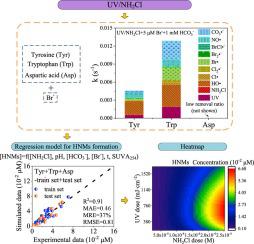当前位置:
X-MOL 学术
›
Sep. Purif. Technol.
›
论文详情
Our official English website, www.x-mol.net, welcomes your feedback! (Note: you will need to create a separate account there.)
Regression model and pathways of halonitromethane formation from amino acids in the presence of bromide ion under UV/monochloramine disinfection
Separation and Purification Technology ( IF 8.6 ) Pub Date : 2024-03-19 , DOI: 10.1016/j.seppur.2024.127159 Bohui Xu , Lin Deng , Wei Luo , Xiaoliang Chen
Separation and Purification Technology ( IF 8.6 ) Pub Date : 2024-03-19 , DOI: 10.1016/j.seppur.2024.127159 Bohui Xu , Lin Deng , Wei Luo , Xiaoliang Chen

|
Halonitromethanes (HNMs) including chlorinated and brominated HNMs, a category of nitrogenous disinfection by-products with high toxicity, were formed from amino acids (AAs) in the presence of bromide ion (Br) under UV/monochloramine (UV/NHCl) disinfection. This study developed a regression model using water characteristics (pH, HCO and Br) and disinfection conditions (disinfection time and NHCl doses) to predict HNM formation from AAs (tyrosine (Tyr), tryptophan (Trp) and aspartic acid (Asp)) in the presence of Br under UV/NHCl disinfection. Main contributors to the abatement of Tyr and Trp were UV (6.1%-18.7%), HO (18.5%-62.3%), Cl (0.3%-17.9%), Br (2.4%-41.3%, =∼10-10 M·s), Br (1.3%-11.0%, =∼10-10 M·s), NO (2.6%-43.0%) and CO (0%-43.2%) based on the first-principle kinetic model of UV/NHCl/Br process, while the removal ratio of Asp was low. It was responsible for higher HNM concentrations from Tyr and Trp than those from Asp. Due to the decline in HNM concentrations with prolongation of reaction time, HNM concentrations were considered as the quadratic function of disinfection time with coefficients related to water characteristics and NHCl doses. The regression model with backward stepwise regression described HNM formation well. After introducing specific UV absorbance at 254 nm (SUVA) and interaction terms associated with SUVA, HNM formation from three AAs was successfully predicted by one regression equation (R = 0.91, mean absolute error = 0.46, mean relative error = 37%, root-mean-square error = 0.81). Using the optimal regression model, increasing NHCl doses was found to advance the peak time for HNM formation. Besides, obtained heatmaps of HNM formation revealed that a high NHCl dose with a high UV dose or low NHCl dose helped to limit HNM formation. Lastly, the possible formation pathways of HNMs were presented.
中文翻译:

紫外线/一氯胺消毒下溴离子存在下氨基酸形成卤代硝基甲烷的回归模型和途径
卤代硝基甲烷(HNM)包括氯化和溴化HNM,是一类具有高毒性的含氮消毒副产物,由氨基酸(AA)在溴离子(Br)存在下在紫外线/一氯胺(UV/NHCl)消毒下形成。本研究开发了一个回归模型,利用水特性(pH、HCO 和 Br)和消毒条件(消毒时间和 NH4Cl 剂量)来预测 AA(酪氨酸 (Tyr)、色氨酸 (Trp) 和天冬氨酸 (Asp))中的 HNM 形成。 UV/NH4Cl 消毒下存在 Br。 Tyr 和 Trp 减少的主要贡献者是 UV (6.1%-18.7%)、H2O (18.5%-62.3%)、Cl (0.3%-17.9%)、Br (2.4%-41.3%, =∼10-10 M·s)、Br (1.3%-11.0%, =∼10-10 M·s)、NO (2.6%-43.0%) 和 CO (0%-43.2%) 基于紫外线第一原理动力学模型/NHCl/Br工艺,而Asp的去除率较低。 Tyr 和 Trp 的 HNM 浓度高于 Asp 的 HNM 浓度。由于HNM浓度随着反应时间的延长而下降,HNM浓度被认为是消毒时间的二次函数,其系数与水特性和NH4Cl剂量相关。向后逐步回归的回归模型很好地描述了 HNM 的形成。引入 254 nm 处的特定 UV 吸光度 (SUVA) 和与 SUVA 相关的相互作用项后,通过一个回归方程成功预测了三种 AA 的 HNM 形成(R = 0.91,平均绝对误差 = 0.46,平均相对误差 = 37%,根-均方误差 = 0.81)。使用最佳回归模型,发现增加 NHCl 剂量可以提前 HNM 形成的峰值时间。此外,获得的 HNM 形成热图表明,高 NH4Cl 剂量和高 UV 剂量或低 NH4Cl 剂量有助于限制 HNM 的形成。最后,提出了HNMs可能的形成途径。
更新日期:2024-03-19
中文翻译:

紫外线/一氯胺消毒下溴离子存在下氨基酸形成卤代硝基甲烷的回归模型和途径
卤代硝基甲烷(HNM)包括氯化和溴化HNM,是一类具有高毒性的含氮消毒副产物,由氨基酸(AA)在溴离子(Br)存在下在紫外线/一氯胺(UV/NHCl)消毒下形成。本研究开发了一个回归模型,利用水特性(pH、HCO 和 Br)和消毒条件(消毒时间和 NH4Cl 剂量)来预测 AA(酪氨酸 (Tyr)、色氨酸 (Trp) 和天冬氨酸 (Asp))中的 HNM 形成。 UV/NH4Cl 消毒下存在 Br。 Tyr 和 Trp 减少的主要贡献者是 UV (6.1%-18.7%)、H2O (18.5%-62.3%)、Cl (0.3%-17.9%)、Br (2.4%-41.3%, =∼10-10 M·s)、Br (1.3%-11.0%, =∼10-10 M·s)、NO (2.6%-43.0%) 和 CO (0%-43.2%) 基于紫外线第一原理动力学模型/NHCl/Br工艺,而Asp的去除率较低。 Tyr 和 Trp 的 HNM 浓度高于 Asp 的 HNM 浓度。由于HNM浓度随着反应时间的延长而下降,HNM浓度被认为是消毒时间的二次函数,其系数与水特性和NH4Cl剂量相关。向后逐步回归的回归模型很好地描述了 HNM 的形成。引入 254 nm 处的特定 UV 吸光度 (SUVA) 和与 SUVA 相关的相互作用项后,通过一个回归方程成功预测了三种 AA 的 HNM 形成(R = 0.91,平均绝对误差 = 0.46,平均相对误差 = 37%,根-均方误差 = 0.81)。使用最佳回归模型,发现增加 NHCl 剂量可以提前 HNM 形成的峰值时间。此外,获得的 HNM 形成热图表明,高 NH4Cl 剂量和高 UV 剂量或低 NH4Cl 剂量有助于限制 HNM 的形成。最后,提出了HNMs可能的形成途径。



























 京公网安备 11010802027423号
京公网安备 11010802027423号